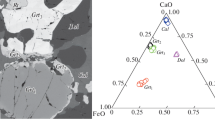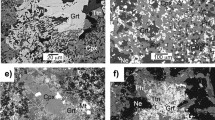Abstract
Results of experimental study at 7.0–8.5 GPa and 1300–1900°C of the systems pyrope Mg3Al2Si3O12 (Prp)-Na2MgSi5O12 (NaGrt) modeling solid solutions of Na-bearing garnets, Prp-jadeite NaAlSi2O6 (Jd) in a simplified mode demonstrating melting relations of Na-rich eclogite, and Prp-Na2CO3 are presented. Prp-Na2MgSi5O12 join is a pseudobinary that results from the decomposition of NaGrt on to coesite and Na-pyroxene. Synthesized garnets are characterized by Na admixture (>0.32 wt % Na2O) and excess Si (3.05–3.15 f.u.). Maximal Na2O concentrations (1.5 wt % Na2O) are reached on the solidus of the system at 8.5 GPa. Clear correlation between Na and Si was established in synthesized garnets; this provides evidence for heterovalent isomorphism of the Mg + Al → Na + Si type with the appearance of Na2MgSi5O12 component as a mechanism of such garnet formation. The Prp-Jd join is also pseudobinary that results from the formation of two series of solid solutions: (1) garnet (Prp-NaGrt-majorite) and (2) pyroxene (Jd-clinoenstatite-Eskola molecule), and the appearance of kyanite at the solidus of the system, where garnets with the highest Na2O contents (>0.8 wt %) are formed. In spite of quite a wide field of garnet crystallization (20–100 mol % Prp), garnets with significant sodium concentration (>0.3 wt % Na2O) are formed in a Jd-rich part of the system (20–50 mol % Prp). In the Prp-Na2CO3 system at 8.5 GPa garnet crystallizes in a wide range of starting compositions as a liquidus mineral containing up to 0.9 wt % Na2O. Our experiments demonstrate that melt alkalinity, as well as PT-parameters control the crystallization of Na-bearing majoritic garnets. The results obtained provide evidence for the fact that the majority of natural diamonds with inclusions of Na-bearing majoritic garnets containing <0.4 wt % Na2O were formed in alkaline silicate (carbonate-silicate) melts at a pressure of <7 GPa. Only a small portion of garnets with higher sodium concentrations (>1 wt % Na2O) could be formed at a pressure of >8.5 GPa. 1 This article was translated by the authors.
Similar content being viewed by others
References
N. V. Sobolev, Deep-Seated Inclusions in Kimberlites and the Problems of Composition of Upper Mantle (Nauka, Novosibirsk, 1974) [in Russian].
J. W. Harris, “Diamond Geology,” in The Properties of Natural and Synthetic Diamond, Ed. by J. E. Field (Academic Press, London, 1992), pp. 345–393.
H. O. A. Meyer, “Inclusions in Diamond,” in Mantle Xenoliths, Ed. by P. H. Nixon (Wiley, New York, 1987), pp. 501–522.
L. A. Taylor and M. Anand, “Diamonds: Time Capsules from the Siberian Mantle,” Chem. Erde 64, 1–74 (2004).
B. H. Scott Smith, R. U. Danchin, J. W. Harris, and K. J. Stracke, “Kimberlites near Orroroo, South Australia,” in Kimberlites I: Kimberlites and Related Rocks, Ed. by J. Kornprobst (Elsevier, Amsterdam, 1984), pp. 121–142.
B. Harte and J. W. Harris, “Lower Mantle Associations Preserved in Diamonds,” Mineral. Mag. 58A, 384–385 (1994).
P. C. Hayman, M. G. Kopylova, and F. V. Kaminsky, “Lower Mantle Diamonds from Rio Soriso (Juina Area, Mato Grosso, Brazil),” Contrib. Mineral. Petrol. 149, 430–445 (2005).
T. Stachel, G. P. Brey, and J. W. Harris, “Kankan Diamonds (Guinea) I: from the Lithosphere down to the Transition Zone,” Contib. Mineral. Petrol. 140, 1–15 (2000).
T. Stachel, J. W. Harris, G. P. Brey, and W. Joswig, “Kankan Diamonds (Guinea) II: Lower Mantle Inclusion Parageneses,” Contib. Mineral. Petrol. 140, 16–27 (2000).
R. M. Davies, W. L. Griffin, and S. Y. O’Reilly, “Diamonds from the Deep: Pipe DO27, Slave Craton, Canada,” in Proc. 7th Intern. Kimb. Conf, Ed. by J. J. Gurney, J. L. Gurney, M. D. Pascoe, and S. H. Richardson (Cape Town, Red Roof Design, 1999), Vol. 1, pp. 148–155.
R. M. Davies, W. L. Griffin, S. Y. O’Reilly, and T. E. McCandless, “Inclusions in Diamonds from the K14 and K10 Kimberlites, Buffalo Hills, Alberta, Canada: Diamond Growth in a Plume?,” Lithos. 77, 99–111 (2004).
N. P. Pokhilenko, N. V. Sobolev, V. N. Reutsky, et al., “Crystalline Inclusions and C Isotope Ratios in Diamonds from the Snap Lake/King Lake Kimberlite Dyke System: Evidence of Ultradeep and Enriched Lithospheric Mantle,” Lithos 77, 57–67 (2004).
R. O. Moore and J. J. Gurney, “Pyroxene Solid Solution in Garnets Included in Diamonds,” Nature 318, 553–555 (1985).
B. Harte and N. Cayzer, “Decompression and Unimixing of Crystals Included in Diamonds from the Mantle Transition Zone,” Phys. Chem. Minerals 34, 647–656 (2007).
W. Wang, S. Sueno, E. Takahashi, et al., “Enrichment Processes at the Base of the Archean Lithospheric Mantle: Observations from Trace-Element Characteristics of Pyropic Garnet Inclusions in Diamond,” Contrib. Mineral. Petrol. 139, 720–733 (2000).
P. Deines, J. W. Harris, and J. J. Gurney, “The Carbon Isotopic Composition and Nitrogen Content of Lithospheric and Asthenospheric Diamonds from the Jagersfontein and Koffiefontein Kimberlite, South Africa,” Geochim. Cosmochim. Acta 55, 2615–2625 (1991).
N. M. McKenna, J. J. Gurney, J. Klump, and J. M. Davidson, “Aspects of Diamond Mineralisation and Distribution at the Helam Mine, South Africa,” Lithos 77, 193–208 (2004).
M. T. Hutchison, Constitution of Deep Transition Zone and Lower Mantle Shown by Diamonds and Their Inclusions Unpublished PhD Thesis (University of Edinburgh, 1997), Vol. 1.
N. V. Sobolev, E. S. Efimova, L. F. Reimers, et al., “Mineral Inclusions in the Diamonds of the Arkhangel’sk Kimebrlite Province,” Geol. Geofiz. 38(2), 358–370 (1997).
N. V. Sobolev, A. M. Logvinova, D. A. Zedgenizov, et al., “Mineral Inclusions in Microdiamonds and Macrodiamonds from Kimberlites of Yakutia: A Comparative Study,” Lithos 77, 225–242 (2004).
R. O. Moore and J. J. Gurney, “Mineral Inclusions in Diamond from the Monastery Kimberlite, South Africa,” in Kimberlites and Related Rocks, Ed. by J. Ross (Blackwell Sci. Publ., Melbourne, 1989), pp. 1029–1041.
T. Stachel, “Diamonds from the Asthenosphere and the Transition Zone,” Eur. J. Mineral. 13, 883–892 (2001).
B. Harte, J. W. Harris, M. T. Hutchinson, G. R. Watt, and M. C. Wilding, “Lower Mantle Mineral Associations in Diamonds from Sao Luiz, Brazil,” in Mantle Petrology: Field Observations and High Pressure Experimentation: A Tribute to Francis R. (Joe) Boyd, Ed. by Y. Fei, C. M. Bertka, and B. O. Mysen (Geochemical Society, Houston, 1999), pp. 125–153.
F. V. Kaminsky, O. D. Zakharchenko, R. Davies, et al., “Superdeep Diamonds from the Juina Area, Mato Grosso State, Brazil,” Contrib. Mineral. Petrol. 140, 734–753 (2001).
M. Akaogi and A. Akimoto, “Pyroxene-Garnet Solid-Solution Equilibria in the Systems Mg4Si4O12-Mg3Al2Si3O12 and Fe4Si4O12-Fe3Al2Si3O12 at High Pressures and Temperatures,” Phys. Earth Planet. Inter. 15, 90–106 (1977).
T. Gasparik, “Transformation of Enstatite-Diopside-Jadeite Pyroxenes to Garnet,” Contrib. Mineral. Petrol. 102, 389–405 (1989).
T. Gasparik, “Enstatite-Jadeite Join and Its Role in the Earth’s Mantle,” Contrib. Mineral. Petrol. 111, 283–298 (1992).
T. Gasparik, “Diopside-Jadeite Join at 16–22 GPa,” Phys. Chem. Minerals 23, 476–486 (1996).
T. Gasparik, “Experimental Investigations of the Origin of Majoritic Garnet Inclusions in Diamonds,” Phys. Chem. Miner. 29, 170–180 (2002).
T. Irifune, T. Sekine, A. E. Ringwood, and W. O. Hibberson, “The Eclogite-Garnetite Transformation at High Pressure and Some Geophysical Implications,” Geotektonika 77, 245–256 (1986).
T. Irifune, “An Experimental Investigation of the Pyroxene-Garnet Transformation in a Pyrolite Composition and Its Bearing on the Constitution of the Mantle,” Phys. Earth Planet. Inter. 45, 324–336 (1987).
K. D. Litasov and E. Ohtani, “Phase Relations in Hydrous MORB at 18–28 GPa: Implications for Heterogeneity of the Lower Mantle,” Phys. Earth Planet. Inter. 150, 239–263 (2005).
S. Ono and A. Yasuda, “Compositional Change of Majoritic Garnet in a MORB Composition from 7 to 17 GPa and 1400 to 1600 Degrees C,” Phys. Earth Planet. Inter. 96, 171–179 (1996).
M. Akaogi and S. Akimoto, “High Pressure Phase Equilibria in a Garnet Lherzolite, with Special Reference to Mg2+-Fe2+ Partitioning among Constituent Minerals,” Phys. Earth Planet. Inter. 19, 31–51 (1979).
A. E. Ringwood and A. Major, “Synthesis of Majorite and Other High Pressure Garnets and Perovskites,” Earth Planet. Sci. Lett. 12, 411–418 (1971).
M. C. Wilding, A Study of Diamonds with Syngenetic Inclusions, Unpublished PhD Thesis (University of Edinburgh, Edinburgh, 1990).
T. Stachel, J. W. Harris, and G. P. Brey, “REE Patterns of Peridotitic and Eclogitic Inclusions in Diamonds from Mwadui (Tanzania),” in Proc. 7th Intern. Kimb. Conf., Ed. by J. J. Gurney, J. L. Gurney, M. D. Pascoe, and S. H. Richardson (Cape Town, Red Roof Design, 1999), Vol. 2, pp. 829–835.
D. D. Badyukov, “High-Pressure Phases in Impactites of the Zhamanshin Crater (USSR),” in Proc. 16th Lunar Planet. Sci. Conf. (Lunar Planet. Sci. Inst., Houston, 1985), pp. 21–22.
N. V. Sobolev, E. S. Yefimova, and V. I. Koptil, “Mineral Inclusions in Diamonds in the Northeast of the Yakutian Diamondiferous Province,” in Proc. 7th Intern. Kimb. Conf., Ed. by J. J. Gurney, J. L. Gurney, M. D. Pascoe, and S. H. Richardson (Red Roof Design, Cape Town, 1999), Vol. 2, pp. 816–822.
N. V. Sobolev and Ju. G. Lavrent’ev, “Isomorphic Sodium Admixture in Garnets Formed at High Pressures,” Contib. Mineral. Petrol. 31, 1–12 (1971).
T. E. McCandless and J. J. Gurney, “Sodium in Garnet and Potassium in Clinopyroxene: Criteria for Classifying Mantle Eclogites,” in Kimberlites and Related Rocks, Ed. by J. Ross (Blackwell Sci., Melbourne, 1989), pp. 827–832.
F. C. Bishop, J. V. Smith, and J. B. Dawson, “Na, K, P and Ti in Garnet, Pyroxene and Olivine from Peridotite and Eclogite Xenoliths from African Kimberlites,” Lithos 11, 155–173 (1978).
R. N. Thompson, “Is Upper Mantle Phosphorus Contained in Sodic Garnet?,” Earth Planet. Sci. Lett. 26, 417–424 (1975).
S. E. Haggerty and V. Sautter, “Ultra-Deep (>300 km) Ultramafic, Upper Mantle Xenoliths,” Science 248, 993–996 (1990).
Yu. A. Litvin, Physicochemical Studies of Melting of Earth’s Deep Materials (Nauka, Moscow, 1991) [in Russian].
A. V. Bobrov, Yu. A. Litvin, L. Bindi, and A. M. Dymshits, “Phase Relations and Formation of Sodium-Rich Majoritic Garnet in the System Mg3Al2Si3O12-Na2MgSi5O12 at 7.0 and 8.5 GPa,” Contrib. Mineral. Petrol. 156, 243–257 (2008).
C. G. Homan, “Phase Diagram of Bi up to 140 kbars,” J. Phys. Chem. Solids 36, 1249–1254 (1975).
C. S. Kennedy and G. C. Kennedy, “The Equilibrium Boundary between Graphite and Diamond,” J. Geophys. Res. 81, 2467–2470 (1976).
A. V. Spivak and Yu. A. Litvin, “Diamond Synthesis in Multicomponent Carbonate-Carbon Melts of Natural Chemistry: Elementary Process and Properties,” Diamond Relat. Mater. 13, 482–487 (2004).
A. V. Bobrov and Yu. A. Litvin, “Experimental Study of the Mg3Al2Si3O12-Na2MgSi5O12 System at 7.0 and 8.5 GPa: Implication for the Formation of Na-Bearing Garnets,” Dokl. Akad. Nauk 419(2), 242–246 (2007) [Dokl. Earth Sci. 419, 339–342 (2008)].
V. S. Sobolev and A. V. Sobolev, “Composition of Deep-Seated Pyroxenes and Problem of Eclogite Barrier,” Geol. Geofiz., No. 12, 46–59 (1977).
N. V. Sobolev, I. K. Kuznetsova, and N. I. Zyuzin, “The Petrology of Grospydite Xenoliths from the Zagadochnaya Kimberlite Pipe in Yakutia,” J. Petrol. 9, 253–280 (1968).
A. V. Bobrov and Yu. A. Litvin, “Formation of Diamond in the Peridotite-Carbonate-Carbon Melts at 7.0–8.5 GPa: Concentration Barrier of Nucleation and Syngenesis of Silicate Inclusions,” Vestn. Otd. Nauk Zemle RAN, No. 1 (25) (2007). URL: http://www.scgis.ru/Russian/cp1251/h_dgggms/1-2007/Informbul-1_2007/term-10.pdf.
M. Schrauder and O. Navon, “Hydrous and Carbonatitic Mantle Fluids in Fibrous Diamonds from Jwaneng, Botswana,” Geochim. Cosmochim. Acta 58(2), 761–771 (1994).
L. F. Dobrzhinetskaya, H. W. Green II, A. P. Renfro, et al., “Precipitation of Pyroxenes and Mg2SiO4 from Majoritic Garnet: Simulation of Peridotite Exhumation from Great Depth,” Terra Nova 16, 325–330 (2004).
R. M. Hazen and L. W. Finger, “Crystal Structures and Compressibilities of Pyrope and Grossular to 60 kbar,” Am. Mineral. 63, 297–303 (1978).
O. Klein-BenDavid, E. S. Izraeli, E. Hauri, and O. Navon, “Fluid Inclusions in Diamonds from the Diavik Mine, Canada and the Evolution of Diamond-Forming Fluids,” Geochim. Cosmochim. Acta 71, 723–744 (2007).
A. Johannsen, A Descriptive Petrography of the Igneous Rocks (University of Chicago Press, Chicago, 1931), Vol. 1, pp. 88–92.
Author information
Authors and Affiliations
Additional information
Original Russian Text © A.V. Bobrov, A.M. Dymshits, Yu.A. Litvin, 2009, published in Geokhimiya, 2009, No. 10, pp. 1011–1026.
Rights and permissions
About this article
Cite this article
Bobrov, A.V., Dymshits, A.M. & Litvin, Y.A. Conditions of magmatic crystallization of Na-bearing majoritic garnets in the earth mantle: Evidence from experimental and natural data. Geochem. Int. 47, 951–965 (2009). https://doi.org/10.1134/S0016702909100012
Received:
Published:
Issue Date:
DOI: https://doi.org/10.1134/S0016702909100012




